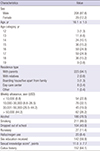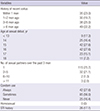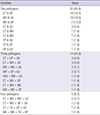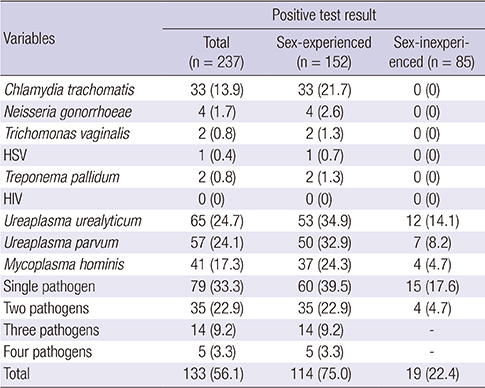1. Dehne KL, Riedner G. Sexually Transmitted Infections among Adolescents: the Need for Adequate Health Services. Geneva: World Health Organization;2005.
2. World Health Organization. Report on Global Sexually Transmitted Infection Surveillance 2013. Geneva: World Health Organization;2014.
3. Chinsembu KC. Sexually transmitted infections in adolescents. Open Infect Dis J. 2009; 3:107–117.
4. Carmine L, Castillo M, Fisher M. Testing and treatment for sexually transmitted infections in adolescents--what's new? J Pediatr Adolesc Gynecol. 2014; 27:50–60.
5. Wallin KL, Wiklund F, Luostarinen T, Angström T, Anttila T, Bergman F, Hallmans G, Ikäheimo I, Koskela P, Lehtinen M, et al. A population-based prospective study of Chlamydia trachomatis infection and cervical carcinoma. Int J Cancer. 2002; 101:371–374.
6. Choi JH, Jeung IC, Pak YG, Park DC. Prevalence and risk factors of Chlamydia trachomatis and Neisseria gonorrhea among Korean women. Korean J Obstet Gynecol. 2007; 50:1739–1746.
7. Farley TA, Hadler JL, Gunn RA. The syphilis epidemic in Connecticut: relationship to drug use and prostitution. Sex Transm Dis. 1990; 17:163–168.
8. Cates W Jr, Wasserheit JN. Genital chlamydial infections: epidemiology and reproductive sequelae. Am J Obstet Gynecol. 1991; 164:1771–1781.
9. Harwell TS, Trino R, Rudy B, Yorkman S, Gollub EL. Sexual activity, substance use, and HIV/STD knowledge among detained male adolescents with multiple versus first admissions. Sex Transm Dis. 1999; 26:265–271.
12. Lee SJ, Cho YH, Kim CS, Shim BS, Cho IR, Chung JI, Lee JG, Kim ME. Screening for chlamydia and gonorrhea by strand displacement amplification in homeless adolescents attending youth shelters in Korea. J Korean Med Sci. 2004; 19:495–500.
13. Friberg J, Gnarpe H. Mycoplasmas in semen from fertile and infertile men. Andrologia. 1974; 6:45–52.
14. O'leary WM. Ureaplasmas and human disease. Crit Rev Microbiol. 1990; 17:161–168.
15. Keck C, Gerber-Schäfer C, Clad A, Wilhelm C, Breckwoldt M. Seminal tract infections: impact on male fertility and treatment options. Hum Reprod Update. 1998; 4:891–903.
16. Deguchi T, Yoshida T, Miyazawa T, Yasuda M, Tamaki M, Ishiko H, Maeda S. Association of Ureaplasma urealyticum (biovar 2) with nongonococcal urethritis. Sex Transm Dis. 2004; 31:192–195.
17. Anagrius C, Loré B, Jensen JS.
Mycoplasma genitalium: prevalence, clinical significance, and transmission. Sex Transm Infect. 2005; 81:458–462.
18. Waites KB, Katz B, Schelonka RL. Mycoplasmas and ureaplasmas as neonatal pathogens. Clin Microbiol Rev. 2005; 18:757–789.
19. Huppert JS, Mortensen JE, Reed JL, Kahn JA, Rich KD, Hobbs MM.
Mycoplasma genitalium detected by transcription-mediated amplification is associated with Chlamydia trachomatis in adolescent women. Sex Transm Dis. 2008; 35:250–254.
20. Shipitsyna E, Krasnoselskikh T, Zolotoverkhaya E, Savicheva A, Krotin P, Domeika M, Unemo M. Sexual behaviours, knowledge and attitudes regarding safe sex, and prevalence of non-viral sexually transmitted infections among attendees of youth clinics in St. Petersburg, Russia. J Eur Acad Dermatol Venereol. 2013; 27:e75–e84.
21. Jaworski BC, Carey MP. Development and psychometric evaluation of a self-administered questionnaire to measure knowledge of sexually transmitted diseases. AIDS Behav. 2007; 11:557–574.
22. Choe HS, Lee DS, Lee SJ, Hong SH, Park DC, Lee MK, Kim TH, Cho YH. Performance of Anyplex™ II multiplex real-time PCR for the diagnosis of seven sexually transmitted infections: comparison with currently available methods. Int J Infect Dis. 2013; 17:e1134–e1140.
23. Lee SY, Lee HJ, Kim TK, Lee SG, Park EC. Sexually transmitted infections and first sexual intercourse age in adolescents: the nationwide retrospective cross-sectional study. J Sex Med. 2015; 12:2313–2323.
24. Stamm WE.
Chlamydia trachomatis infections: progress and problems. J Infect Dis. 1999; 179:Suppl 2. S380–S383.
25. Choi JY, Cho IC, Lee GI, Min SK. Prevalence and associated factors for four sexually transmissible microorganisms in middle-aged men receiving general prostate health checkups: a polymerase chain reaction-based study in Korea. Korean J Urol. 2013; 54:53–58.
26. Kim SJ, Lee DS, Lee SJ. The prevalence and clinical significance of urethritis and cervicitis in asymptomatic people by use of multiplex polymerase chain reaction. Korean J Urol. 2011; 52:703–708.
27. Castillo Mezzich A, Tarter RE, Giancola PR, Lu S, Kirisci L, Parks S. Substance use and risky sexual behavior in female adolescents. Drug Alcohol Depend. 1997; 44:157–166.
28. Slater C, Robinson AJ. Sexual health in adolescents. Clin Dermatol. 2014; 32:189–195.
29. Ministry of Justice (KR). 2014 Crime Prevention Policy Bureau statistics in Korean [Internet]. accessed on 30 September 2016. Available at
http://www.cppb.go.kr/.










 PDF
PDF ePub
ePub Citation
Citation Print
Print




 XML Download
XML Download